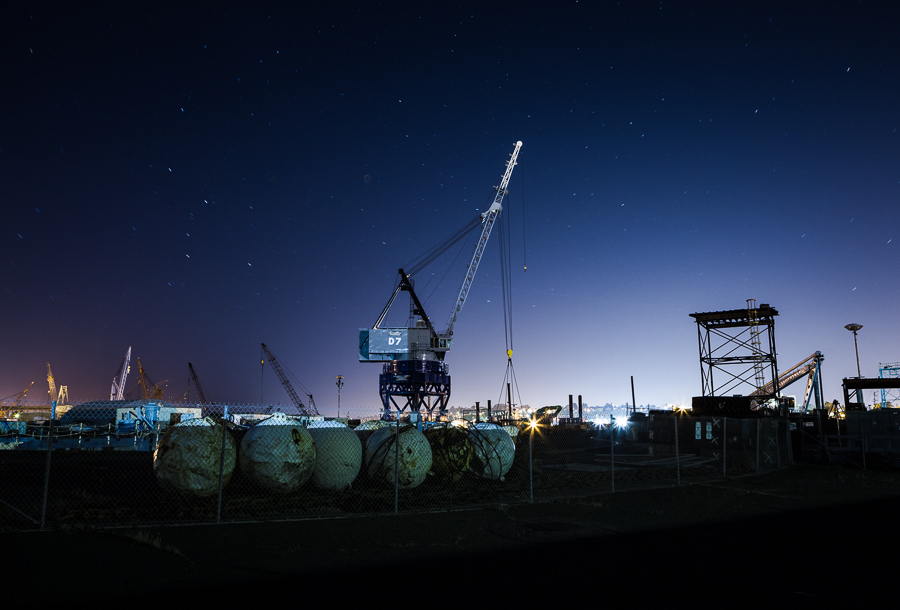Shooting and processing HDR night photography from Mare Island
The Nocturnes head honcho Tim Baskerville lives on Mare Island, and has been hosting occasional night photography events there since 2006. Mare Island Naval Shipyard was established in 1854, and decommissioned in 1996. A wide variety of old buildings and dry docks remain. Mare Island has enough lighting for night photography whether there is a full moon or not. The mixed lighting conditions can be challenging for night photography. Below are four images from last Saturday's adventure, along with notes about how to shoot and process HDR night photography. The dry docks and cranes at Mare Island are always a interesting subject for night photography. Unfortunately, these areas are fenced, which makes getting a good camera position tough. A lot of photographers at the event marveled at my solution to this problem. I have a Gitzo 3541XLS tripod (now the Gitzo 3542XLS) that goes up to 6.6 feet tall. Add the height of the ballhead and camera, and you can easily shoot over a standard fence, which is how I got this shot.
The image is composed of a five shot bracket of 8 seconds, 15 seconds, 30 seconds, 1 minute, and 2 minutes at f/8, ISO 200. The 5 images were blended together using Exposure Fusion in Photomatix. Then I brought the blended image into Photoshop. Using a layer mask, I used the foreground from the blended HDR image, and the sky from the 2 minute exposure.
Natural Looking HDR
<rant> HDR is a dirty word (or dirty acroynm) in some circles, due to rampant abuse of HDR software. I used to blend exposures on a layer mask to make sure my photos looked like photos instead of clown puke. Over the last few years I've realized that HDR can be used for very natural looking results. I want my photographs to look like photographs, not some bad Photoshop filter from the 1990's. Anyhow, HDR can save you a lot of time when you're shooting at night under mixed lighting conditions. If you're interested in learning HDR techniques, I highly recommend Christian Bloch's The HDRI Handbook 2.0. Even experienced HDR shooters will pick up some great techniques from this book. </rant> Let's continue with some more night photography examples.
My compositional style typically favors the grand view instead of detail shots. I did two different setups for the picture of this truck, and ended up liking the tighter framing above. This image is a three shot bracket of 24 seconds, 46 seconds, and 2 minutes at f/9.5, ISO 200. The three images were merged to HDR in Photoshop, and the resulting 32-bit TIFF file was processed in Lightroom. The light in the window at the bottom right was blown out, even in the shortest exposure. I was planning to shoot a few shorter exposures, but I had to move my tripod. I was setup in the middle of the road, and a car drove through before I could finish. The bright area could be adjusted by simply using the clone stamp to bring some tonal value back in the bottom window panes, although I'm not sure that it bothers me.
I scouted this shot during a walk at sunset, and was happy with how dark and mysterious the area looked at night. Shooting this image proved to be complicated because a bright orange building light behind me kept turning off and on every 2-3 minutes. I ended up with a five shot bracket of 15 seconds, 30 seconds, 1 minute, and 2 minutes at f/9.5, ISO 200. The fifth shot was also 2 minutes at f/9.5, but at ISO 400.
The building light was on for a few seconds in a couple of the exposures. I thought this might help with a little bit of fill light, but it ended up making the resulting colors look weird when I merged to HDR in Photoshop. The Photomatix Fusion results looked better, but the image still had a slight HDR look. I used the 2 minute exposure for the sky, and tried layering the HDR version on top for more foreground detail. The tone of the image looked just about right, but the color in the buoys still looked a little bit off. I switched the HDR image layer with the foreground detail to Luminosity Blend Mode -- problem solved! The tone looked good, and the colors looked natural.
The hardest part of this shot was smelling the fumes from the nearby buildings that are used to paint large pipes. The foreground is a four shot bracket of 45 seconds, 90 seconds, 3 minutes, and 6 minutes at f/9.5, ISO 200. After reviewing the bracketed shots on the back of the camera, I noticed that Orion's Belt would be in a good position in the sky soon. I waited a few minutes, and then made a 10 minute exposure at f/11, ISO 100. The 5 shot bracket was blended with Exposure Fusion in Photomatix. The foreground is the HDR image, and the sky is from the 10 minute exposure.
I hope these shooting and post-processing details are useful for those who are interested in shooting HDR at night. You can see bigger versions of these photos, and more night photography of Mare Island on my website.



